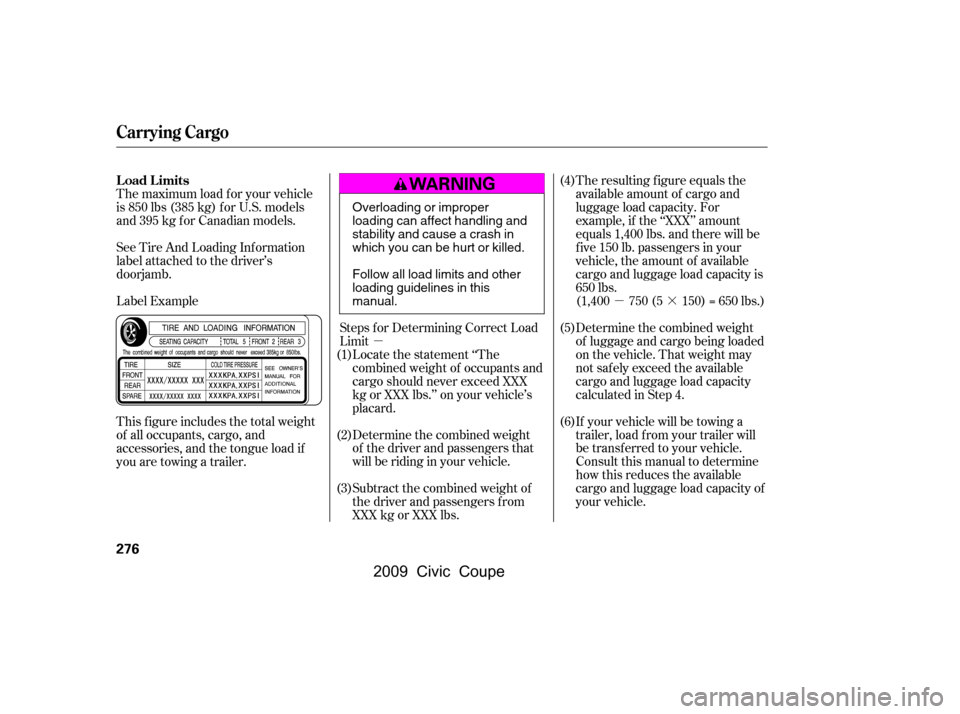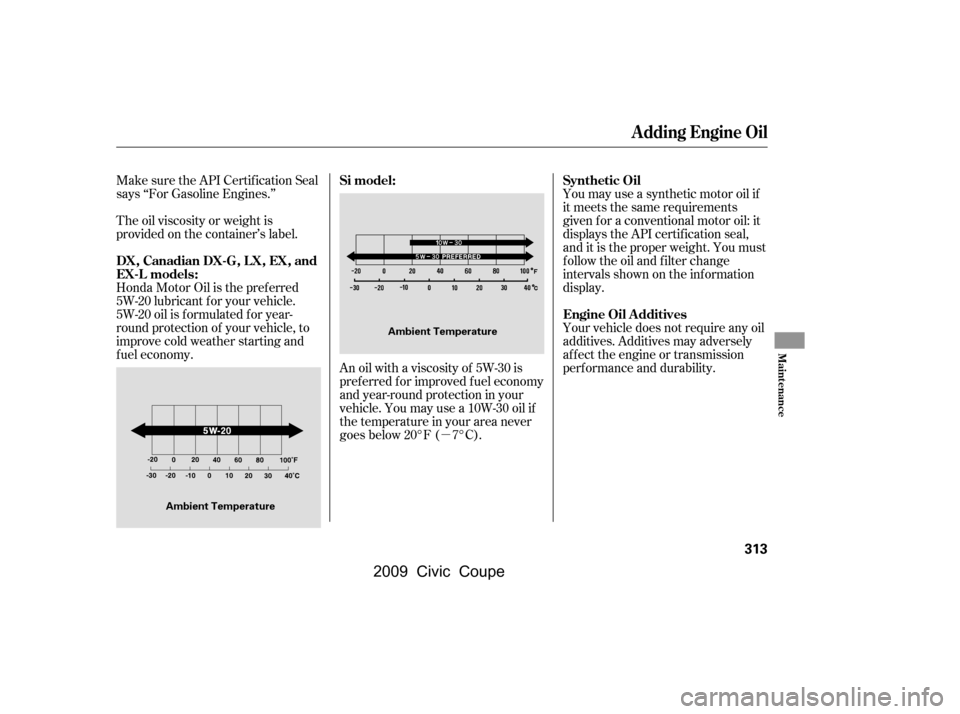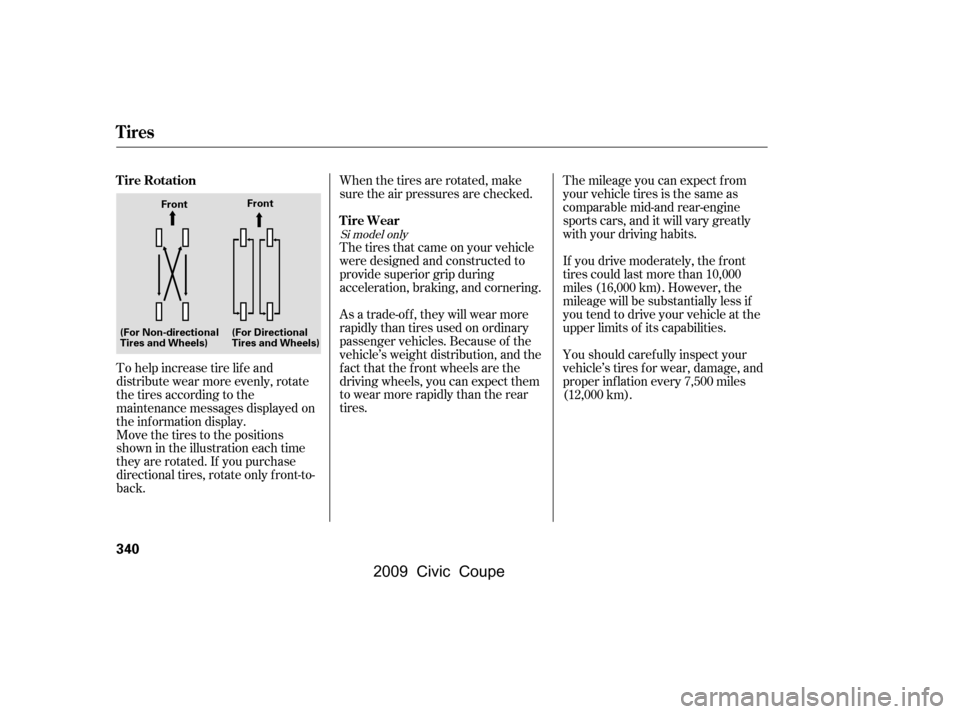Page 279 of 412

�µ�µ�·
Steps f or Determining Correct Load
Limit Locate the statement ‘‘The
combined weight of occupants and
cargo should never exceed XXX
kg or XXX lbs.’’ on your vehicle’s
placard.
Determine the combined weight
of the driver and passengers that
will be riding in your vehicle.
Subtract the combined weight of
the driver and passengers f rom
XXX kg or XXX lbs. The resulting f igure equals the
available amount of cargo and
luggage load capacity. For
example, if the ‘‘XXX’’ amount
equals 1,400 lbs. and there will be
f ive 150 lb. passengers in your
vehicle, the amount of available
cargo and luggage load capacity is
650 lbs.
(1,400 750 (5 150) = 650 lbs.)
Determine the combined weight
of luggage and cargo being loaded
on the vehicle. That weight may
not saf ely exceed the available
cargo and luggage load capacity
calculated in Step 4.
If your vehicle will be towing a
trailer, load f rom your trailer will
be transf erred to your vehicle.
Consult this manual to determine
how this reduces the available
cargo and luggage load capacity of
your vehicle.
The maximum load f or your vehicle
is 850 lbs (385 kg) f or U.S. models
and 395 kg for Canadian models.
See Tire And Loading Inf ormation
label attached to the driver’s
doorjamb.
This f igure includes the total weight
of all occupants, cargo, and
accessories, and the tongue load if
you are towing a trailer.
Label Example
(1)
(2)
(3) (4)
(5)
(6)
Load Limits
Carrying Cargo
276
Overloading or improper
loading can affect handling and
stability and cause a crash in
which you can be hurt or killed.
Follow all load limits and other
loading guidelines in this
manual.
�\f���—�\f���—�\f���y�
�
�������\f���y���
�(�+�������\f�y�\f�����
�y
2009 Civic Coupe
Page 280 of 412
In addition, the total weight of the
vehicle, all occupants, accessories,
cargo, and trailer tongue load must
not exceed the Gross Vehicle
Weight Rating (GVWR) or the Gross
Axle Weight Rating (GAWR). Both
areonalabelonthedriver’s
doorjamb.
Example 1
Example 2
Example 3
Carrying Cargo
Bef ore Driving
277
Max Load (850 lbs) Cargo Weight
(550 lbs)
Max Load (850 lbs)
Max Load (850 lbs) Cargo Weight
(250 lbs)
Cargo Weight
(100 lbs)
Passenger Weight
(150 lbs x 2 = 300 lbs)
Passenger Weight
(150 lbs x 4 = 600 lbs)
Passenger Weight
(150 lbs x 5 = 750 lbs)
�\f���—�\f���—�\f���y�
�
�������\f���y���
�(�+�������\f�y�\f�������y
2009 Civic Coupe
Page 316 of 412

�µYou may use a synthetic motor oil if
it meets the same requirements
given f or a conventional motor oil: it
displays the API certif ication seal,
and it is the proper weight. You must
f ollow the oil and f ilter change
intervals shown on the information
display.
Your vehicle does not require any oil
additives. Additives may adversely
af f ect the engine or transmission
perf ormance and durability.
An oil with a viscosity of 5W-30 is
pref erred f or improved f uel economy
and year-round protection in your
vehicle. You may use a 10W-30 oil if
the temperature in your area never
goes below 20°F ( 7°C).
Make sure the API Certif ication Seal
says ‘‘For Gasoline Engines.’’
The oil viscosity or weight is
provided on the container’s label.
5W-20 oil is f ormulated f or year-
round protection of your vehicle, to
improve cold weather starting and
f uel economy.
Honda Motor Oil is the pref erred
5W-20 lubricant f or your vehicle.
Synthetic Oil
Engine Oil A dditives
Si model:
DX, Canadian DX-G, L X, EX, and
EX-L models:
A dding Engine Oil
Maint enance
313
Ambient Temperature
Ambient Temperature
�\f���—�\f���—�\f���y�
�
�����������y���
�(�+�������\f�y�\f���
���y
2009 Civic Coupe
Page 335 of 412
If equipped
Dirt build-up in the loops of the seat
belt anchors can cause the belts to
retract slowly. Wipe the insides of
the loops with a clean cloth
dampened in mild soap and warm
water or isopropyl alcohol.If you remove a f loor mat, make sure
tore-anchoritwhenyouputitback
in your vehicle.
If you use a non-Honda f loor mat,
make sure it f its properly and that it
canbeusedwiththefloormat
anchors. Do not put additional f loor
mats on top of the anchored mat.
The driver’s and right rear
passenger’s f loor mats that came
with your vehicle hook over the f loor
mat anchors. This keeps the f loor
mats f rom sliding f orward and
possibly interf ering with the pedals
(driver’s floor mat) or with the seat
weight sensors (right rear f loor mat).
Floor Mats
Cleaning the Seat Belts, Floor Mats
332
�\f���—�\f���—�\f���y�
�
�����������y���
�(�+�������\f�y�\f�������y
2009 Civic Coupe
Page 342 of 412
The last f our digits of the TIN (tire
identif ication number) are f ound on
the sidewall of the tire and indicate
the date of manufacture (Seeon page ). In addition to proper inf lation,
correct wheel alignment helps to
decrease tire wear. If you f ind a tire
is worn unevenly, have your dealer
check the wheel alignment.
Have your dealer check the tires if
you f eel a consistent vibration while
driving. A tire should always be
rebalanced if it is removed f rom the
wheel. When you have new tires
installed, make sure they are
balanced. This increases riding
comf ort and tire lif e. For best results,
have the installer perform a dynamic
balance.
381
For vehicles equipped with aluminum
wheels:
Tire
Labeling T ire Maintenance
Tires
Maint enance
339
Improper wheel weights can damage
your vehicle’s aluminum wheels. Use
only Honda wheel weights f or
balancing.
�\f���—�\f���—�\f���y�
�
����\f������y���
�(�+�������\f�y�\f�������y
2009 Civic Coupe
Page 343 of 412

To help increase tire lif e and
distribute wear more evenly, rotate
the tires according to the
maintenance messages displayed on
the information display.
Move the tires to the positions
shown in the illustration each time
they are rotated. If you purchase
directional tires, rotate only f ront-to-
back.Themileageyoucanexpectfrom
yourvehicletiresisthesameas
comparable mid-and rear-engine
sports cars, and it will vary greatly
with your driving habits.
If you drive moderately, the f ront
tires could last more than 10,000
miles (16,000 km). However, the
mileage will be substantially less if
you tend to drive your vehicle at the
upper limits of its capabilities.
You should caref ully inspect your
vehicle’s tires f or wear, damage, and
proper inf lation every 7,500 miles
(12,000 km).
As a trade-of f , they will wear more
rapidly than tires used on ordinary
passenger vehicles. Because of the
vehicle’s weight distribution, and the
fact that the front wheels are the
driving wheels, you can expect them
to wear more rapidly than the rear
tires.
The tires that came on your vehicle
were designed and constructed to
provide superior grip during
acceleration, braking, and cornering.
When the tires are rotated, make
sure the air pressures are checked.
Si model only
Tires
Tire Rotation
Tire Wear
340
FrontFront
(For Non-directional
Tires and Wheels) (For Directional
Tires and Wheels)
�\f���—�\f���—�\f���y�
�
����\f������y���
�(�+�������\f�y�\f�������y
2009 Civic Coupe
Page 374 of 412
Emergency Towing
T aking Care of t he Unexpect ed
371
Trying to lif t or tow your vehicle by the
bumpers will cause serious damage.
The bumpers are not designed to
support the vehicle’s weight.The steering system can be damaged if
the steering wheel is locked. Leave the
ignition switch in the ACCESSORY (I)
position, and make sure the steering
wheel turns f reely bef ore you begin
towing.
�\f���—�\f���—�\f���y�
�
�����������y���
�(�+�������\f�y�\f�������y
2009 Civic Coupe
Page 379 of 412
�Î
�Î�Î�Î
�Î
�Î �Î
�Î
�Î
�Î
�Î
�Î
�Î
�Î
�Î
�Î
Specif ications
376
Dimensions Engine
Weights
Seating Capacities 174.8 in (4,440 mm)
68.9 in (1,751 mm)
53.5 in (1,358 mm)
104.3 in (2,650 mm)
59.0 in (1,499 mm)
59.9 in (1,522 mm)
Length
Width
Height
Wheelbase
Track
Type
BorexStroke
Displacement
Compression ratio
Spark plugs
Spark plugsWater cooled 4-stroke
SOHC VTEC , DOHC i-VTEC 4-cylinder gasoline engine
3.19 x 3.44 in (81.0 x 87.3 mm) 3.39x3.39in(86x86mm) 110 cu-in (1,799 cm
)
122 cu-in (1,998 cm)
10.5
11.0
NGK:
DENSO: IZFR6K-11S
SKJ20DR-M11S
IFR7G-11KS
SK22PR-M11S
Gross vehicle weight rating See the certification label attached to the driver’s doorjamb.
Total
Front
Rear 3
2
5
60.2 in (1,528 mm)
Front
Rear
NGK:
DENSO:
1:
2: DX, Canadian DX-G, LX, EX, EX-L
Si
1:
2:
LX, Canadian DX-G (M/T), EX, EX-L
DX, Canadian DX-G (A/T)
1
2 12
1
2 1
2
1
2
1
2
�\f���—�\f���—�\f���y�
�
�������\f���y���
�(�+�������\f�y�\f�����
�y
2009 Civic Coupe